Use 'Print preview' to check the number of pages and printer settings.
Print functionality varies between browsers.
Printable page generated Thursday, 25 April 2024, 2:18 AM
Study Session 7 Pollution: Types, Sources and Characteristics
Introduction
You were introduced to wastes and pollutants in Study Session 1, where we discussed the interactions between humans and our environment. Pollution was defined as the introduction into the environment of substances liable to cause harm to humans and other living organisms. Many human activities pollute our environment, adversely affecting the water we drink, the air we breathe, and the soil in which we grow food.
In this and the next study session we will look more closely at pollution. In this session you will learn about the different types and sources of pollution and the various human activities that can cause pollution. We will also describe the ways pollution can affect different sectors of the environment: water, air and soil. Study Session 8 describes some of the significant effects of pollution on the environment and on human health. It also discusses options for preventing and controlling pollution.
Learning Outcomes for Study Session 7
When you have studied this session, you should be able to:
7.1 Define and use correctly all of the key words printed in bold. (SAQs 7.1, 7.2, 7.3 and 7.4)
7.2 Describe the main types of pollution. (SAQ 7.3)
7.3 Describe the sources of pollution and the way pollutants reach the environment. (SAQ 7.4)
7.4 Describe the main characteristics of water, air and soil pollution. (SAQ 7.5)
7.1 What is pollution?
If you hold up a glass of water in front of you, how can you tell if it’s polluted? You would expect drinking water to be colourless, odourless and transparent (not turbid with suspended particulates). If it was not all of these things, then it could be polluted. If you were looking at water in a river, it is unlikely to be as clear as drinking water in a glass, but you could deduce it was probably not polluted if you observed that the water did not look dirty or smell bad. You might also observe that animals were drinking the water without ill effects and fish were swimming in it. However, if the water was discoloured or had an unpleasant odour, or you could see dead fish floating on the surface you could conclude that pollution was the problem.
Let us consider the human activity that could have caused the pollution. Imagine a river that flows through an area of land on the edges of a town. The water is used by the community for drinking and other domestic uses and also for vegetable farming. Several residents use this water to irrigate small areas of land where they cultivate vegetables and many of the farmers use fertiliser and pesticide to improve productivity (Figure 7.1). Fertilisers are made of chemicals such as nitrogen, potassium and phosphorus, which are essential plant nutrients. Pesticides are chemicals that destroy pests but can be harmful to other forms of life – including humans.
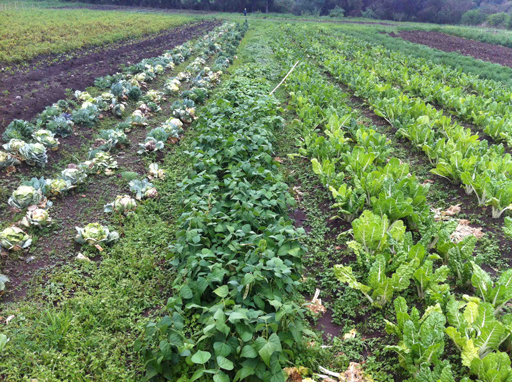
Imagine that one farmer has finished spreading the chemicals on his crop and decides to wash the empty pesticide sack he has been using in the river. Later that day, it rains heavily and rainwater is seen running off the field into the river. What do you think happens? The river is receiving run-off containing fertiliser and pesticide chemicals that had been applied to the crops, which is made worse by the farmer washing his sack that had contained the pesticide. This could harm fish and other organisms living in the water – possibly killing them. The river is also used by the community so the chemicals could get into drinking water that is consumed by humans. The river has been polluted by the careless action of the farmer washing his sack and by the action of rainwater washing the chemicals into the river.
Pollution always has a source and a recipient. The source is where the pollution comes from, that is, where the pollution is released into the environment. The recipient is where the pollution ends up, which may be a part of the environment or people or animals that become contaminated or damaged.
In the above example about the farmer washing the pesticide sack in the river, what is the source and what is the recipient of the pollution?
The pollution source is the activity of urban farming with pesticides and fertilisers and washing sacks so that pollutants get into the river. In this example, the primary recipient is the water body that receives the pollutants. Other recipients are the people who drink the contaminated water and animals such as fish that also are affected.
There are a number of ways of identifying pollution. These include finding symptoms of damage to aquatic plants and animals (such as dead fish), finding chemicals in the water, comparing the previous history of the quality of water with the present quality, and getting complaints from water users. Even when a problem has been found, investigations to identify the source may take time. For example, water samples from several different points upstream and downstream will need to be analysed to locate precisely where the problem originated.
There are several different ways of classifying pollutants. They can be categorised by their physical nature, by their source, by the recipient or by the sector of the environment affected. In the following sections we will look at each of these classification groups
7.2 Physical nature of the pollutant
Pollutants may be in the form of gas, liquid, solid or energy.
What polluting gases can you think of?
Greenhouse gases are pollutants that contribute to human-induced climate change (mentioned in Study Session 1). The main greenhouse gases are carbon dioxide, methane and nitrogen oxides.
Liquid pollutants usually come from liquid waste. Liquid waste includes human excreta (both faeces and urine), industrial wastewaters and other forms of waste from water-using activities (Figure 7.2). Factories generate liquid waste from activities related to washing in the manufacturing process, cleaning objects and chemical mixing. Sewage is a mixture of human excreta from water-flushed toilets and other wastewater from houses and businesses. Sewage and human waste from overflowing septic tanks and latrines are frequent sources of pollution.

Urban run-off is another type of liquid waste that can cause pollution. Rainwater washes many different types of waste from the land surface into lakes and rivers. Urban run-off can contain a lot of organic matter. This may come from open defecation or inappropriate handling of organic wastes produced from households and businesses. Organic matter includes anything that is derived from living organisms, such as human and animal wastes, decaying plants and food wastes.
Pollutants also come in solid form. Plastic bags are one of the most common solid wastes. Solid waste is any solid material that is assumed not to be useful and is therefore thrown away. Factories, businesses and households produce different kinds of solid waste such as paper, plastics, metals, chemicals in solid form, pieces of cloth or food and animal remains (Figure 7.3). Sometimes you may have observed faecal matter discarded with solid waste, which adds to the problems.
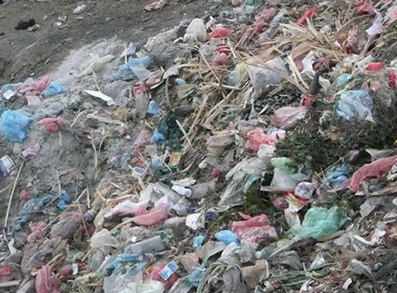
There is a fourth type of pollution that is common in urban communities. This is energy in the form of noise pollution. Noise pollution means unacceptable levels of noise in work, residential and recreational places. Noise makes it difficult to have a conversation and also irritates and disturbs us and in the long term can damage our hearing. Loud music from music shops and clubs in an urban community is a known source of noise disturbance. Such noise may please some, but it disturbs many other people because it interferes with communication in the daytime and sleeping at night.
7.3 Sources of pollution
Another way of classifying pollution is by the sector of human activity that produces it. Before we look at the various sectors, there is an important distinction to be made about pollution sources. Sources of pollution can be categorised as point or non-point sources. Point sources are identifiable points or places that you can easily locate. An example is a diesel truck that produces visible black exhaust fumes from its tailpipe. Liquid waste released from a pipe into a river is another example (Figure 7.4). A non-point source (also known as ‘diffuse pollution’) is one where it is difficult to identify the exact origin of the pollution. A good example is floodwater that washes all types of waste from the land (possibly including faecal matter) into a river. In this situation you cannot identify the individual or household or establishment that has caused the water pollution (Figure 7.5).
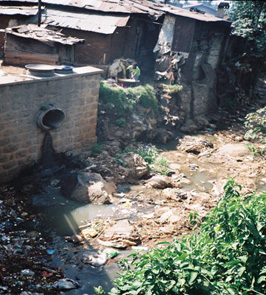
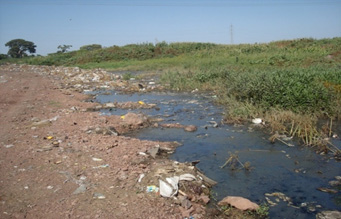
Can you think of examples of point and non-point source pollution from earlier in this study session?
The farmer washing his sack is an example of a point source because you could identify where he washed his sack. However, the pesticide washing from the field is an example of a non-point source. The pollutant would wash into the river at several places, and could possibly also have come from other fields. This is an example of how difficult it can sometimes be to accurately identify the source.
7.3.1 Domestic sources
Domestic sources of pollution include toilets, latrines and wastewater from kitchens and bathrooms. If these wastes are properly contained and prevented from getting into the environment, they will not cause pollution. However, frequently this is not the case. Open defecation obviously releases human waste into the environment, which can then be washed into rivers and other surface waters.
What types of organic waste are produced by a typical household?
The organic wastes from domestic sources include human excreta and also food waste and other kitchen waste such as cooking oil residues.
Solid wastes from households and also from shops, markets and businesses include food waste, packaging materials and other forms of rubbish. Domestic sources are also responsible for gaseous pollutants in the form of smoke and carbon dioxide from domestic fires.
7.3.2 Industry
Pollution from the industrial sector in Ethiopia has been on the rise, posing a serious problem to the environment. Many industrial processes produce polluting waste substances that are discharged to the environment, frequently through chimneys (to the air) or through pipes (to surface water) (Figure 7.6). Among the most polluting industries are food processing, tanneries and textiles with processing plants and factories that produce liquid effluents which are discharged into rivers, often without treatment (Ademe and Alemayehu, 2014; Wosnie and Wondie, 2014). In practice, rivers frequently receive polluting discharges from many different sources all at the same time. The Little Akaki River in Addis Ababa, for example, is polluted by several different industrial sources as well as by domestic wastes (Tegegn, 2012).
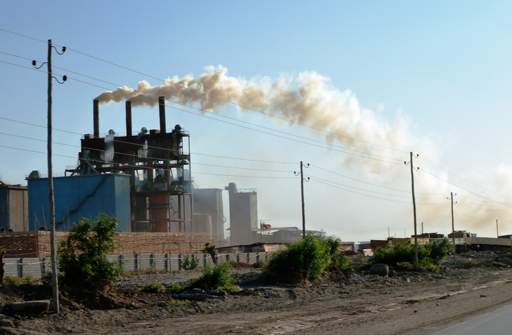
7.3.3 Agriculture
Like industry, agricultural activities are also increasing in Ethiopia, and changing too. Nowadays, agricultural activities in Ethiopia use more pesticides and fertilisers. Ethiopia imports over 3000 tons of various types of pesticides annually (Federal Environment Protection Authority, 2004). Fertiliser use in Ethiopia has increased from 140,000 metric tons in the early 1990s to around 650,000 metric tons in 2012 (Rashid et al., 2013). Fertiliser contains phosphate and nitrate and if these reach water bodies they can cause excessive plant growth (Figure 7.7).
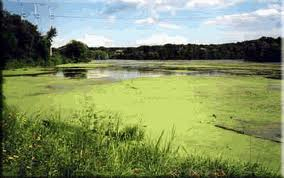
Agriculture is also responsible for gaseous pollutants in the form of methane produced by livestock and solid pollutants from crop residues, packaging materials and other wastes similar to those produced domestically. Animals also contribute to waste products and potential pollutants with their excrement.
7.3.4 Transport
Do you live in a city or have you visited a city close to where you live? If so you will no doubt be familiar with the variety of vehicles on our roads (Figure 7.8). Some are small cars, others are heavy motor trucks. These vehicles differ not only in their size, but also by using different types of fuel such as petrol, diesel, and blended fuel (10% ethanol and petrol). If you observe the tailpipe of diesel engine vehicles, you will have seen the black exhaust gas produced. The intensity of the black colour is greater for poorly maintained vehicles, to the extent sometimes that it makes the air hazy or smoky and causes coughs and eye irritation. The lack of a policy to remove old vehicles from the roads adds to the problem. Tiwari (2012) found that nearly a third of vehicles in Addis Ababa were over 30 years old, resulting in high levels of tailpipe emissions. Traffic jams, common in all big cities, make the problems worse.

7.4 Pathways of pollution
We said earlier that pollution always has a source and a recipient. The pathway of pollution is the way the pollutant moves from the source, enters into the environment, and finally how it reaches the human body or other recipient. The pathway between source and recipient can take several different forms depending on the type of pollutant. Primary recipients for pollution are water, air, and soil. Pollutants usually reach humans through the consumption of contaminated and polluted water and food, and breathing polluted air.
Once released into the environment, the worst effects of many pollutants are reduced by one or more of the following processes:
- Dispersion – smoke disperses into the air and is no longer noticeable away from the source.
- Dilution – soluble pollutants are diluted in the water of a river or lake.
- Deposition – some suspended solids carried in a river settle (are deposited) on the river bed.
- Degradation – some substances break down (degrade) by natural processes into different, simpler substances that are not polluting.
In each case the effect is to reduce the concentration of the pollutant. Concentration is a measure of the amount of the substance in a known volume of water or air. The units used for water pollutants are usually milligrams per litre (mg/l, also written as mg l-1), although sometimes you may see ppm which stands for ‘parts per million’.
These processes do not apply to all pollutants. There are some persistent pollutants which remain intact when released into the environment because they do not break down by natural processes. These are described in Study Session 8.
7.5 Sector of the environment affected by pollution
Classifying pollution by the sector of the environment affected – water, air, soil and land – is probably the most commonly used method.
7.5.1 Water pollution
Water pollution can affect surface water such as rivers and lakes, soil moisture and groundwater in aquifers, and the oceans. As you know from Study Session 4, the actions of the water cycle connect all these different reservoirs of water. For example, a polluted river will discharge into the ocean and could damage the marine environment. However, the volume of water in the ocean can disperse and dilute the pollutant so that its worst effects are only felt near the mouth of the river.
Water pollution is characterised by the presence of excess physical, chemical or biological substances that change the qualities of the water and are capable of causing harm to living organisms. We mentioned earlier that natural or unpolluted water is colourless, odourless and transparent. Water that tastes or smells bad or is cloudy can be said to have the symptoms of water pollution. However, some water pollutants cannot be seen or tasted, for example some chemicals, such as pesticides, and most of the micro-organisms that cause waterborne diseases. So, water pollution involves more than just the appearance of the water. Polluted water should not be used for drinking, washing, bathing or agriculture. If polluted water is used by humans, then it can adversely affect the body in different ways, depending on the type and concentration of pollutant.
You also read in Study Session 4 that most rivers and streams in Ethiopia contain significant quantities of suspended solids that are carried along in the flow and make the water look brown in colour, especially in the rainy season (Figure 7.9). Most of the solids are fine particles of soil that have been washed into the river from surrounding land by rain, often following cultivation or construction work. Large quantities of solids in the water can reduce light penetration into the water which can affect the growth of plants.
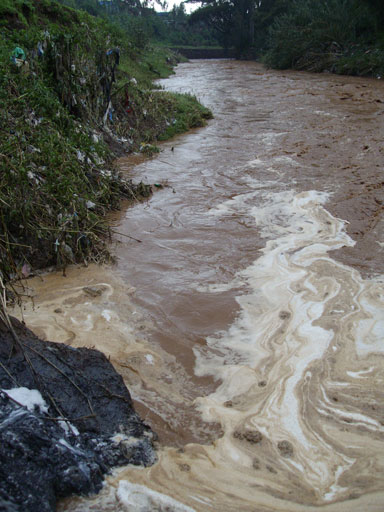
Biological water pollutants are micro-organisms that are harmful to humans and other forms of life. They are responsible for many different waterborne diseases. The original source of these pollutants is people or animals already infected with the micro-organisms concerned. If faeces from infected people are not correctly contained and treated, the pollutants can get into surface and groundwater. The main groups of biological pollutants are bacteria, viruses, protozoa and helminths (worms).
Chemical water pollutants take many different forms depending on their source. They include plant nutrients (compounds of phosphorus and nitrogen) used as fertilisers which, as you read earlier, can be washed from fields into rivers. These nutrients are also produced by the breakdown of human and animal wastes and are common pollutants of surface waters.
Chemical pollutants also include heavy metals, pesticides and other persistent pollutants. Heavy metals are a group of toxic chemical pollutants that contain compounds of persistent metals such as mercury, cadmium, lead and chromium. The presence of heavy metals in water in excess of acceptable levels can cause illness and death among animals and humans if consumed through drinking and food (Zinabu and Pearce, 2003).
Persistent organic pollutants (POPs) are also toxic to humans and wildlife. They include many different synthetic organic chemicals manufactured for use as pesticides and in industrial processes, e.g. DDT, aldrin and PCBs (polychlorinated biphenyls). Many of these persistent chemicals have been banned in some countries. Their persistence in the environment creates specific problems that are described in Study Session 8.
7.5.2 Air pollution
Air pollution can exist at all scales, from local to global, and can include gases and solid particles. It can affect you in your own home, or in your town or city, and can contribute to global atmospheric changes. The most common sources of air pollution in the urban centres of Ethiopia include the burning of wood, charcoal and other biomass fuel by households, small businesses such as bakeries, manufacturing industries, and vehicles.
Air pollution is defined as the presence in the air of abnormal amounts of chemical constituents capable of causing harm to living organisms. Clean air consists of nitrogen (78% by volume), oxygen (21%) and trace gases (
The emission of black smoke is an indication of intense pollution. However, not all air pollution is visible or can be smelled. Gases such as carbon monoxide and carbon dioxide are invisible and odourless. Carbon monoxide is very dangerous to humans. It can be produced by inefficient burning of fuel (for example a charcoal stove in a home with inadequate air supply) and if breathed in large quantities it can be deadly. Carbon dioxide is an important pollutant that is involved in climate change. (You will learn about in climate change in Study Sessions 9, 10 and 11.)
7.5.3 Soil and land pollution
Soil pollution, also called land pollution, is linked to water pollution. Liquid wastes containing toxic chemicals or pathogenic micro-organisms on the surface of the land can seep slowly into the soil and may percolate down to contaminate groundwater, which can affect people using springs or wells in the area. Possible sources include open defecation, pit latrines or leaking storage containers for industrial chemicals and wastes.
Solid waste can cause soil pollution. A collection of solid wastes in one place or scattered around is unsightly and might smell bad to you as you pass by (Figure 7.10). Household waste typically consists mostly of food waste that will gradually decompose. This produces a bad odour and attracts insects and rats, both of which contribute to the transmission of disease. As the waste decomposes it produces a liquid called leachate which trickles down into the soil. Leachate is a highly concentrated liquid pollutant that may contain toxic chemicals and pathogenic micro-organisms as well as high levels of organic compounds. Rainwater falling on, and washing through, solid waste adds to the problem.

Summary of Session 7
In Study Session 7, you have learned that:
- Environmental pollution is the result of human activity and development that occurs when physical, biological and chemical agents are released to the environment in such quantities that the pollution adversely affects human health and damages the environment.
- Pollution can be classified by its physical nature, by its source, by its recipient, by the sector affected or by its effects.
- Pollution may be in the form of a gas, liquid, solid or energy.
- Sources of pollution may be point sources, which are easily identified, or non-point sources, where the pollution comes from diffuse sources that are not easy to pinpoint.
- There are different types of pollution: water pollution, air pollution, solid waste pollution and noise pollution. All of these can be found in urban areas.
- The main sources of pollution are household activities, factories, agriculture and transport.
- Once they have been released into the environment, the concentration of some pollutants is reduced by dispersion, dilution, deposition or degradation.
- Water can be contaminated by physical pollutants (solid material), biological pollutants (such as bacteria that cause waterborne diseases), and many different chemical pollutants.
- Air pollution can be caused by gases or solid particulates.
- Soil pollution is linked to groundwater pollution. Solid waste can produce highly polluting leachate which contaminates soil groundwater.
Self-Assessment Questions (SAQs) for Study Session 7
Now that you have completed this study session, you can assess how well you have achieved its Learning Outcomes by answering these questions.
SAQ 7.1 (tests Learning Outcome 7.1)
Why is a point source of pollution easier to identify than a non-point source of pollution?
Answer
Point sources of pollution are easier to identify because they come from points or places that you can easily locate, such as a pipe discharging waste into a river. A non-point source is more difficult to identify because it does not come from just one place, but can come from a wide area, for example fertiliser washing off a number of fields or floodwater that washes waste from latrines.
SAQ 7.2 (tests Learning Outcome 7.1)
Rewrite the sentences below using terms from the list provided to fill the gaps:
concentration, heavy metals, organic matter, persistent pollutant, sewage.
……………… consists of human excreta and wastewater. It has a high ……………… of ………………
Some pollutants, called ………………, do not break down naturally in the environment. Examples are mercury, cadmium and other ………………
Answer
Sewage consists of human excreta and wastewater. It has a high concentration of organic matter.
Some pollutants, called persistent pollutants, do not break down naturally in the environment. Examples are mercury, cadmium and other heavy metals.
SAQ 7.3 (tests Learning Outcomes 7.1 and 7.2)
Describe what is meant by the terms liquid waste and solid waste, using examples from your own experience to illustrate your answer.
Answer
Liquid waste is liquid material that is thrown away, or discharged into the environment. From the household you might include human excreta (both faeces and urine) and other wastewaters. In your area you might also see urban run-off when rain washes waste from the land surface. You might also see liquid waste discharged from factories through a pipe into a river.
Solid waste is any solid material that is assumed not to be useful and is therefore thrown away; examples that you might use include food waste, cloth, paper and plastic that are thrown out from your own household or that you see in the area where you live.
SAQ 7.4 (tests Learning Outcomes 7.1 and 7.3)
For the scenarios (a) to (d), fill in the table below to show the pollutant, the source of pollution, the possible pathways and the recipients:
- a.A farmer washes an empty pesticide sack in a river; the river flows into a lake which is used for drinking water by people from a local town.
- b.Rain falls on a waste dump used to collect household waste; the waste dump isn’t properly sealed and liquid percolates down into the soil and into groundwater that is extracted from a nearby well for domestic use.
- c.A tannery based in a town produces liquid waste that contains organic matter and chemicals used in the tanning process; this effluent is discharged into the local river which flows out of the town and through a nature park.
- d.A bus driving through a busy town emits black smoke from its tailpipe.
| Pollutant | Source | Pathway | Recipient | |
| (a) | ||||
| (b) | ||||
| (c) | ||||
| (d) |
Answer
| Pollutant | Source | Pathway | Recipient | |
| (a) | pesticide | agriculture | through the river | lake, humans |
| (b) | leachate | domestic / household | through soil and groundwater | soil, groundwater, humans |
| (c) | liquid effluent (organic matter and tannery chemicals) | industry | through the river | river, humans, wildlife |
| (d) | black smoke | transport | through the air | humans |
SAQ 7.5 (tests Learning Outcome 7.4)
Describe how water pollution can change the characteristics of water.
Answer
Natural or unpolluted water is colourless, odourless and transparent. Water pollution changes the characteristics of water by the presence of excess physical, chemical or biological substances that change the qualities of the water and are capable of causing harm to living organisms.
Polluted water can taste or smell bad or be cloudy. Polluted water can contain suspended solids that make the water look brown in colour; most of the solids are fine particles of soil that have been washed into the river by rain from surrounding land. Large quantities of solids in the water can reduce light penetration into the water which can affect the growth of plants.
Water pollution changes more than just the appearance of the water. Polluted water can also contain chemicals, such as pesticides, fertilisers and heavy metals that are toxic. Polluted water also can contain biological substances such as organic matter and micro-organisms that cause waterborne diseases.